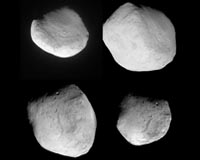 |
Pasadena CA (JPL) Feb 17, 2011 NASA's Stardust spacecraft returned new images of a comet showing a scar resulting from the 2005 Deep Impact mission. The images also showed the comet has a fragile and weak nucleus. The spacecraft made its closest approach to comet Tempel 1 on Monday, Feb. 14, at 8:40 p.m. PST (11:40 p.m. EST) at a distance of approximately 178 kilometers (111 miles). Stardust took 72 high-resolution images of the comet. It also accumulated 468 kilobytes of data about the dust in its coma, the cloud that is a comet's atmosphere. The craft is on its second mission of exploration called Stardust-NExT, having completed its prime mission collecting cometary particles and returning them to Earth in 2006. The Stardust-NExT mission met its goals, which included observing surface features that changed in areas previously seen during the 2005 Deep Impact mission; imaging new terrain; and viewing the crater generated when the 2005 mission propelled an impactor at the comet. "This mission is 100 percent successful," said Joe Veverka, Stardust-NExT principal investigator of Cornell University, Ithaca, N.Y. "We saw a lot of new things that we didn't expect, and we'll be working hard to figure out what Tempel 1 is trying to tell us." Several of the images provide tantalizing clues to the result of the Deep Impact mission's collision with Tempel 1. "We see a crater with a small mound in the center, and it appears that some of the ejecta went up and came right back down," said Pete Schultz of Brown University, Providence, R.I. "This tells us this cometary nucleus is fragile and weak based on how subdued the crater is we see today." Engineering telemetry downlinked after closest approach indicates the spacecraft flew through waves of disintegrating cometary particles, including a dozen impacts that penetrated more than one layer of its protective shielding. "The data indicate Stardust went through something similar to a B-17 bomber flying through flak in World War II," said Don Brownlee, Stardust-NExT co-investigator from the University of Washington in Seattle. "Instead of having a little stream of uniform particles coming out, they apparently came out in chunks and crumbled." While the Valentine's Day night encounter of Tempel 1 is complete, the spacecraft will continue to look at its latest cometary obsession from afar. "This spacecraft has logged over 3.5 billion miles since launch, and while its last close encounter is complete, its mission of discovery is not," said Tim Larson, Stardust-NExT project manager at JPL. "We'll continue imaging the comet as long as the science team can gain useful information, and then Stardust will get its well-deserved rest." Stardust-NExT is a low-cost mission that is expanding the investigation of comet Tempel 1 initiated by the Deep Impact spacecraft. The mission is managed by JPL for NASA's Science Mission Directorate in Washington. Lockheed Martin Space Systems in Denver built the spacecraft and manages day-to-day mission operations.
Share This Article With Planet Earth
Related Links Stardust-Next/Tempel 1 Image Gallery Stardust-NExT at JPL Asteroid and Comet Mission News, Science and Technology
 Spectacular Flyby Of Comet Tempel 1 Tests Lockheed Built Spacecraft
Spectacular Flyby Of Comet Tempel 1 Tests Lockheed Built SpacecraftDenver CO (SPX) Feb 16, 2011 NASA's Stardust-NExT spacecraft made a Valentine's Day deep-space rendezvous with an object it had been seeking for the past four-and-a-half years. The Lockheed Martin-built spacecraft flawlessly executed its mission and performed a flyby of comet Tempel 1 at 9:39 p.m. MT yesterday. Stardust made its closest approach of the nucleus of the comet at a distance of 111 miles (178 km) and was t ... read more |
|
| The content herein, unless otherwise known to be public domain, are Copyright 1995-2010 - SpaceDaily. AFP and UPI Wire Stories are copyright Agence France-Presse and United Press International. ESA Portal Reports are copyright European Space Agency. All NASA sourced material is public domain. Additional copyrights may apply in whole or part to other bona fide parties. Advertising does not imply endorsement,agreement or approval of any opinions, statements or information provided by SpaceDaily on any Web page published or hosted by SpaceDaily. Privacy Statement |